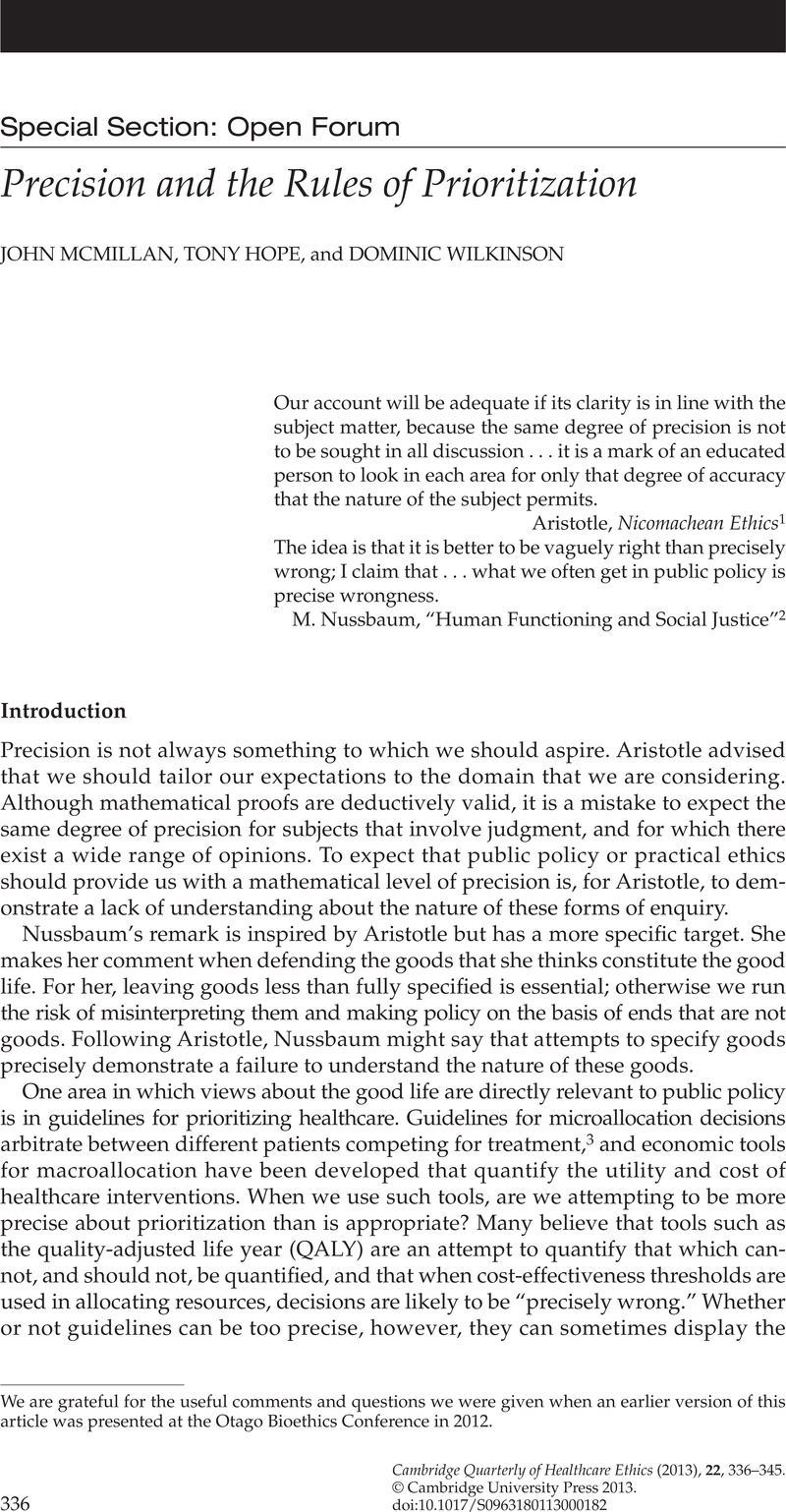Published online by Cambridge University Press: 06 August 2013

1. Aristotle. Nicomachean Ethics. Crisp R, ed. Cambridge: Cambridge University Press; 2000, at 4–5.
2. Nussbaum, M.Human functioning and social justice: In defence of Aristotelian essentialism. Political Theory 1992;20(2):202–46, at 215.Google Scholar
3. Hope T, McMillan J, Hills E. Intensive care triage: Priority should be independent of whether patients are already receiving intensive care. Bioethics 2011. doi: 10.1111/j.1467-8519.2010.01852.x.
4. Braithwaite, J.Rules and principles: A theory of legal certainty. Australian Journal of Legal Philosophy 2002;27:47.Google Scholar
5. Schauer, F.Prescriptions in three dimensions. Iowa Law Review 1996;82:911.Google Scholar
6. Diver, CS.The optimal precision of administrative rules. The Yale Law Journal 1983;93:65–109.CrossRefGoogle Scholar
7. Schäfer, HB.Rules versus standards in rich and poor countries: Precise legal norms as substitutes for human capital in low-income countries. Supreme Court Economic Review 2006:113–134.Google Scholar
8. Raftery, JP.Paying for costly pharmaceuticals: Regulation of new drugs in Australia, England and New Zealand. The Medical Journal of Australia 2008;188(1):26–28.Google Scholar
9. Mushlin, AI, Ghomrawi, H.Health care reform and the need for comparative-effectiveness research. The New England Journal of Medicine 2010;362:3, e6. doi:10.1056/NEJMp0912651.Google Scholar
10. Patient-Centered Outcomes Research Institute; available at http://www.pcori.org (last accessed 1 Feb 2012).
11. Neumann, P, Weinstein, M.Legislating against the use of cost-effectiveness information. The New England Journal of Medicine 2010;363(16):1495–7, at 1495.CrossRefGoogle ScholarPubMed
12. Singer, P, McKie, J, Kushe, H, Richardson, J.Double jeopardy and the use of QALYs in health-care allocation. Journal of Medical Ethics 1995;21(3):144–150.Google Scholar
13. Orentlicher, DD.Rationing health care: It’s a matter of the health care system’s structure. Annals of Health Law 2009;19(3):449–464.Google Scholar
14. The Intensive Care Society. Guidelines for the transport of the critically ill; 2011; available at http://www.ics.ac.uk/professional/guidance_transport_3_3_ (last accessed 29 Nov 2012).
15. See note 14, The Intensive Care Society 2011, at 20
16. The Society of Critical Care Medicine Ethics Committee. Consensus statement on the triage of critically ill patients. JAMA 1994;271:1200–3.
17. The American College of Critical Care Medicine of the Society of Critical Care Medicine. Guidelines for ICU admission, discharge and triage. Critical Care Medicine 1999;27:633–8.
18. See note 16, The Society of Critical Care Medicine Ethics Committee 1994, at 1201.
19. See note 16, The Society of Critical Care Medicine Ethics Committee 1994, at 1201.
20. See note 16, The Society of Critical Care Medicine Ethics Committee 1994, at 1201.
21. Wunsch, H, Harrison, DA, Harvey, S, Rowan, K.End-of-life decisions: A cohort study of the withdrawal of all active treatment in intensive care units in the United Kingdom. Intensive Care Medicine 2005;31(6):823–31.Google Scholar
22. Yaguchi, A, Truog, RD, Curtis, JR, Luce, J, Mitchell, M, Levy, M.International differences in end-of-life attitudes in the intensive care unit: Results of a survey. Arch Intern Med 2005;165(17):1970–5.Google Scholar
23. Gresiuk, CS, Joffe, AR.Variability in the pediatric intensivists’ threshold for withdrawal/limitation of life support as perceived by bedside nurses: A multicenter survey study. Annals of Intensive Care 2011;1(1):31.CrossRefGoogle ScholarPubMed
24. Lorber, J.Spina bifida cystica: Refusals of treatment of 270 consecutive cases with criteria for selection for the future. Archives of Disease in Childhood 1971;47:854–73.CrossRefGoogle Scholar
25. Veatch, R.The technical criteria fallacy. Hastings Center Report 1977 Aug;7(4):15–16.Google Scholar
26. See note 2, Nussbaum 1992, at 222.
27. McDonald, CJ.Guidelines you can follow and can trust: An ideal and an example. JAMA 1994;271(11):872–3.Google Scholar
28. Daniels, N, Sabin, J.Limits to health care: Fair procedures, democratic deliberation and the legitimacy problem for insurers. Philosophy and Public Affairs 1997;26:303–50, at 327.Google Scholar